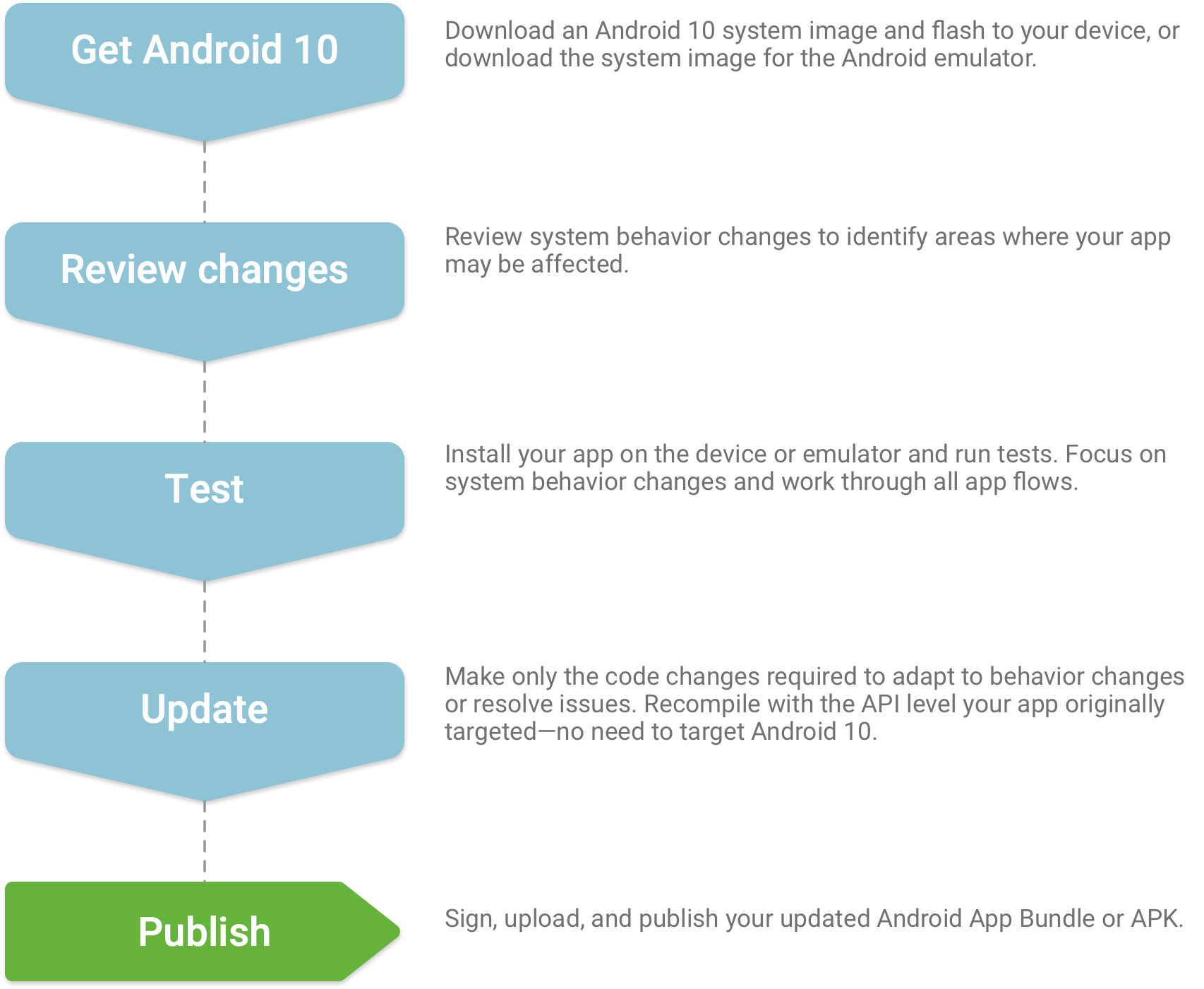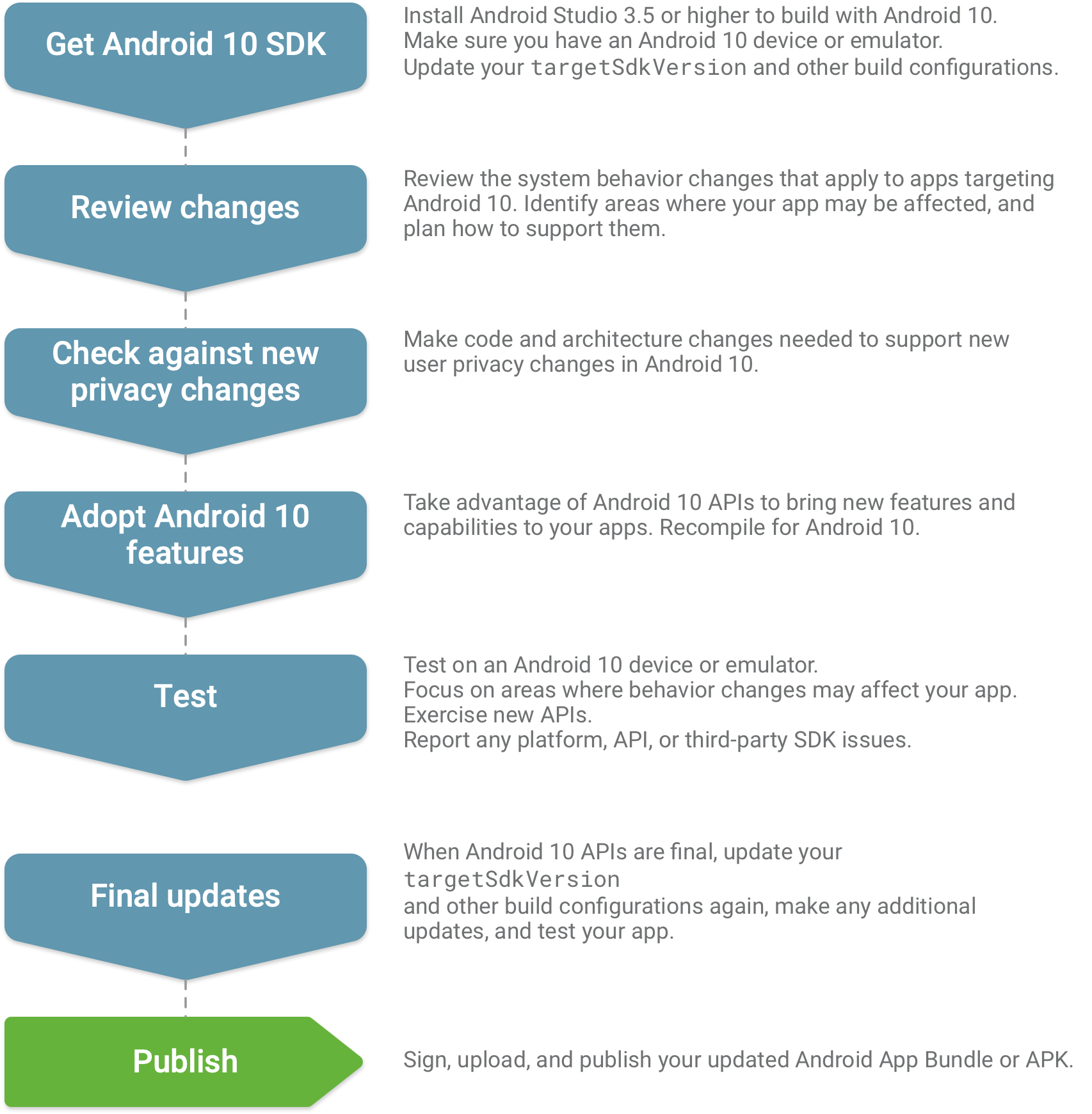欢迎!Android 10 新增了许多 API,可带来新的体验;同时更新了系统行为,这些可能会对 Android 10 设备上运行的应用产生影响。
要开始使用,我们建议您查看系统行为变更、隐私权变更以及新功能和新 API,然后通过以下两个阶段迁移您的应用:
- 确保基本兼容性。请尽快确保您现有的已发布应用已准备好,可供即将更新或购买搭载 Android 10 的新设备的用户使用。请测试您的应用,以验证应用是否功能完备,然后面向用户发布应用的兼容版本。
- 利用 Android 10 功能和 API 进行编译。接下来,探索 Android 10 中的新功能和 API。设置您的开发环境,更改应用的
targetSdkVersion,然后使用与您的应用相关的新 API 进行编译。
以下各部分重点介绍您在这两个阶段需要执行的操作。 在开始之前,请确保您已准备好硬件设备或模拟器来运行并测试您的应用。
第 1 阶段:基本兼容性
这一阶段的目标是,识别应用在 Android 10 上运行时出现的任何功能回归问题或其他影响,然后解决这些问题,并面向用户发布更新版本。在许多情况下,您应该不需要更改应用的 targetSdkVersion 或使用新 API,但您可以选择性地通过更改 compileSdkVersion 来支持兼容性。
一些平台变更可能会影响应用的行为方式,因此请务必在所有流程中测试现有应用的功能。在发布应用的兼容版本后,我们建议您在更新说明中向用户表明该应用支持在 Android 10 下运行。
为了让用户顺利过渡到 Android 10,我们建议您尽早发布应用的兼容版本,最好是在设备开始接收 Android 10 更新之前。

执行测试
兼容性测试与您准备发布应用时执行的测试属于同一类型。这时有必要回顾一下核心应用质量指南和测试最佳实践。
请务必熟悉可能会影响应用的已知行为变更。即使您尚未更改 targetSdkVersion,这些行为变更仍将应用于您的应用。提前查看这些变更将帮助您更快地确定可能受影响的区域并调试所有错误。
Android 10 引入了针对隐私权的大量变更,因此也请务必查看关键的隐私权变更并了解这些变更可能对您的应用产生的影响。
第 2 阶段:利用 Android 10 编译
准备就绪后,您可以探索 Android 10 中的新功能和新 API,并借助这些新体验增强您的应用。要开始使用新 API 来开发应用,您需要在 Android Studio 中设置 Android 10 (API 29) SDK 并将 targetSdkVersion 和 compileSdkVersion 更改为 29。
更改 targetSdkVersion 后,如果您以 Android 10 (API 29) 或更高版本为目标平台,则还需要考虑适用于您的应用的系统行为变更。
一些行为变更可能会导致回归或崩溃问题,因此请务必查看这些变更并进行全面测试,然后再发布更改 targetSdkVersion 的应用更新。

获取 SDK
要获取 SDK 软件包以便利用 Android 10 编译应用,请首先确保您使用的是最新版 Android Studio。如需了解详情,请参阅设置 SDK。
执行测试
完成上述准备工作后,您便可以构建应用,然后对其进行进一步测试,以确保应用在以 Android 10 为目标平台时能够正常运行。这时有必要再次回顾一下核心应用质量指南和测试最佳实践。
如果您在构建应用时将 targetSdkVersion 设置为 29,则应该注意特定的平台变更。即使您尚未使用新 API,Android 10 行为变更页面上所述的一些变更也可能会严重影响您的应用的行为或造成应用崩溃。

